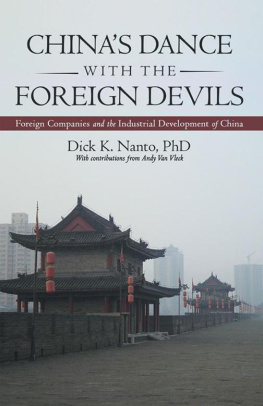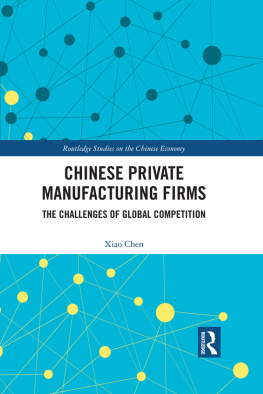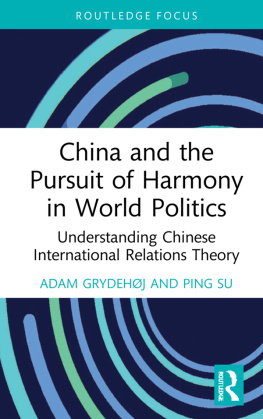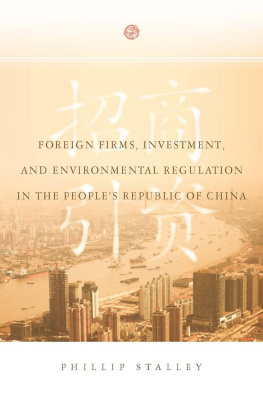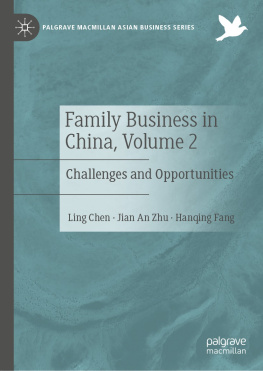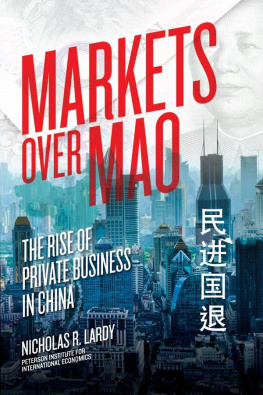PARTNERING WITH CHINESE FIRMS
Partnering with Chinese Firms
Lessons for international managers
Yadong Luo
University of Hawaii
First published 2000 by Ashgate Publishing
Reissued 2019 by Routledge
2 Park Square, Milton Park, Abingdon, Oxon, OX14 4RN
52 Vanderbilt Avenue, New York, NY 10017
Routledge is an imprint of the Taylor & Francis Group, an informa business
Copyright Yadong Luo 2000
All rights reserved. No part of this book may be reprinted or reproduced or utilised in any form or by any electronic, mechanical, or other means, now known or hereafter invented, including photocopying and recording, or in any information storage or retrieval system, without permission in writing from the publishers.
Notice:
Product or corporate names may be trademarks or registered trademarks, and are used only for identification and explanation without intent to infringe.
Publisher's Note
The publisher has gone to great lengths to ensure the quality of this reprint but points out that some imperfections in the original copies may be apparent.
Disclaimer
The publisher has made every effort to trace copyright holders and welcomes correspondence from those they have been unable to contact.
A Library of Congress record exists under LC control number:
ISBN 13: 978-1-138-71118-1 (hbk)
ISBN 13: 978-1-315-20049-1 (ebk)
In an attempt to achieve sustained competitive advantages in global marketplaces, multinational enterprises (MNEs) have turned increasingly to the use of international cooperative ventures. This is particularly evident when MNEs expand into the People's Republic of China, the world's largest emerging market and fastest growing economy in recent years. It has been recognized, however, that making these ventures profitable in China, like elsewhere, is by no means easy. Partner selection significantly determines the success of these cross-border, interorganizational ventures.
This book is mainly written for international managers or business students who are interested in emerging markets, particularly China. It provides conceptual backgrounds, analytical frameworks, managerial insights, business guidance, and practical evidence concerning partner selection for both foreign and Chinese investors. It addresses how foreign companies should select ideal Chinese firms as well as what Chinese firms are looking for from foreign investors.
This book is divided into three parts. The first part () delineates how to select appropriate partner firms from both foreign and Chinese parent's perspectives. The third part includes ten case studies showing how leading MNEs in the world adopt entry and cooperative strategies (including partner selection) that align properly with internal capabilities, external environment, and organizational needs. Based on a variety of archival and internet sources, these case studies are prepared by the author for the purposes of discussion.
In the course of writing this book, I have benefited from a research grant provided by the Center for International Business Education and Research at the University of Hawaii. I am very thankful to David Brice, a doctoral candidate at UH, for his professional and impressive assistance in formatting, typesetting, and indexing the manuscript. As always, this book is dedicated to my family in recognition of their patience and understanding throughout this project.
Yadong Luo, Ph.D.
University of Hawaii
Part I
Partnering with Chinese Firms: Overview
Chapter Purpose
This chapter describes the background on foreign direct investment and multinational corporations in China. The discussion is divided into four sections. The first section provides an overview of foreign direct investment in the world. This is followed by an introduction to some of the characteristics of foreign direct investment in Asia. The third section is a historical review of such investment over the past two decades (1979-1998). The last section illuminates what is occurring now, especially with respect to recently emerging policy changes, and speculates on the future of foreign investment in China.
The 1990s have been an era of globalization, in which rapid growth of international trade, financial flows, and foreign direct investment (FDI) have affected more and more economies in deeper and deeper ways. The benefits of financial globalization, in particular, have been many, but the world economy has also been periodically buffeted by international financial shocks. The latest of these has been the most severe, beginning with the collapse of the Thai baht on 2 July 1997, then spreading to other Asian economies. It has since touched countries on every continent.
Global FDI flow on a balance of payments basis reached record levels in 1997. Both outward and inward investment broke through the US$400 billion mark for the first time, with outward investment up 27.0 percent on 1996 to US$423.7 billion, and inward investment up 18.6 percent to US$400.5 billion. Outward FDI, despite annual decline in 1996, picked up in 1997 due to greater investment by developed nations. Growth in FDI in 1997 was driven mainly by the U.S. and U.K., with the U.S. contributing 12.2 and 4.7 points and the U.K. contributing 7.9 and 3.6 points to growth in outflow and inflow, respectively. Much of the increase in outward FDI by the U.S. was directed at Dutch and British holding companies. U.S. investment in the Netherlands was targeted ultimately at investment in Asia via this country.
According to U.S. statistics, in recent years reinvestment of profits by overseas subsidiaries has accounted for nearly 50 percent of U.S. FDI, as a large proportion of the equity capital comprising new investments takes the form of mergers and acquisitions. Stock-for-stock transactions, developed in the U.S. as a means of acquiring companies, have become widely used for cross-border mergers and acquisitions.
FDI received by developing countries in 1997 rose 14.7 percent over the previous year. FDI inflow to Latin America rose sharply thanks to strong growth in investment in Brazil and Mexico. In Brazil, foreign firms were attracted by large-scale privatization of the electricity and telecom sectors. This was a result of the Brazilian government policy of attracting foreign capital to improve its infrastructure; more than 80 percent of inward FDI was in Brazil's non-manufacturing sector in 1997. Within East Asia, investment grew in China, the Republic of Korea (R.O.K.), Singapore, Taiwan, and Thailand, but fell in Indonesia and the Philippines. FDI inflow to the four members of the Association of Southeast Asian Nations (ASEAN) continued downward, but this accounted for only a small proportion of global FDI. The United Nations Conference on Trade and Development (UNCTAD) estimated that global FDI outflow in 1998 would reach US$430-US$440 billion, even higher than that of 1997.
International production by multinational corporations (MNCs) has been continuously growing in recent years. As shown in lists the world's largest host and home economy FDI flows. It shows that China is the second largest FDI inflow country in the world, surpassed only by the United States.


